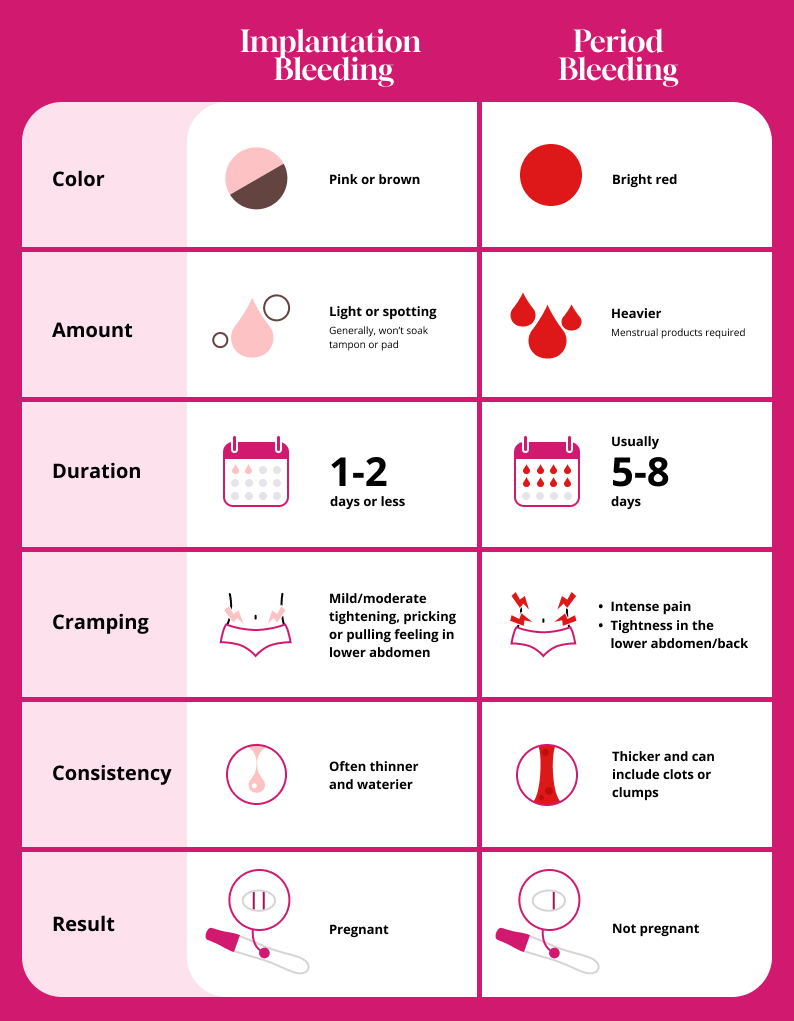How to Recognize Implantation Bleeding: Is It Pregnancy or Just Your Period?

While many people associate a missing period with early pregnancy, you may be surprised to learn that a small amount of blood and cramping – known as implantation bleeding – can also be an early sign. This occurs as the fertilized egg attaches to the uterine lining, marking the beginning of your 9-month journey.
Here’s what you need to know about implantation bleeding and how to determine if it’s a sign of pregnancy or an oncoming period.
What Is Implantation Bleeding & Implantation Cramps?
Implantation bleeding and cramping occur when a fertilized egg attaches to the uterine lining. While they are not the same as menstrual cramps and bleeding, they can happen around the same time as your period, making it confusing.
Every month, your uterine lining builds up with tissue to prepare for a potential fertilized egg. If no egg implants, the lining is shed as your period. However, when an egg implants, it physically embeds into that uterine lining, and some spotting and cramping can be normal as a result.
The resulting lighter bleeding and milder cramping can be one of the first signs of pregnancy. Since it can be difficult to distinguish implantation bleeding from your period (especially if your periods are light), taking a pregnancy test will help you know for sure.
When Does Implantation Bleeding Occur?
Implantation bleeding typically occurs 9-12 days after conception, when the fertilized egg implants or attaches to the lining of the uterus. This process can take as few as 6 days and as many as 14, with an average of around 9 days.
To estimate when implantation may have occurred, knowing when you ovulated and the first date of your last period will help. Ovulation usually occurs 12-14 days after the start of your last cycle, and implantation typically happens 9-14 days after ovulation , if the egg is fertilized.
What Does Implantation Bleeding Look Like?
Even though you may be used to bleeding every month, implantation bleeding, aka implantation spotting, typically looks different than your usual period bleeding.
During implantation, a small amount of the uterine lining can be displaced or disturbed, resulting in light bleeding. During menstruation, the uterus contracts to expel the entire uterine lining, resulting in heavier bleeding that lasts until all the lining is released.
Implantation Bleeding vs Period Bleeding
Implantation bleeding and cramping can easily be mistaken for the onset of your monthly cycle, but what’s happening in your body is completely different. There are differences between implantation and period bleeding in terms of flow amount, duration of bleeding, pain, and the color of the blood.
Here’s a quick comparison so you can know how to tell the difference between implantation bleeding and your period:

How Long Does Implantation Bleeding Last?
Implantation bleeding typically lasts anywhere from a few hours to 1-2 days. If it persists for more than a couple of days or becomes heavier than light spotting, it’s best to consult your doctor, as it could indicate something other than implantation.
What Are Some Symptoms of Implantation Bleeding
Every person is different, but many describe the feeling of implantation as a mild tingling, tightening, or pulling in the uterus. Mild discomfort and a pink or brownish watery discharge are typical symptoms – if you experience implantation bleeding at all.
Since the symptoms of implantation cramping and bleeding can be like those of a light period, you may want to take a pregnancy test to help know if you are pregnant and be on the lookout for other early signs of pregnancy:
- Fatigue
- Tender, swollen, heavier, or fuller breasts
- Nausea or vomiting
- Food aversions or cravings
- Heightened sense of smell
- Mood swings or feeling tearful or easily upset
- Headaches
- Constipation
- Dizziness or feeling faint
- Elevated body temperature
- Missed period
You should always consult with your doctor or medical provider if you experience any symptoms or issues concerning your health.
How Common is Implantation Bleeding?
About 25-30% of pregnant women experience implantation bleeding. While some may notice spotting, others may not experience it at all. It’s important to remember that bleeding early in pregnancy does not automatically indicate a miscarriage. Implantation bleeding is typically light and brief, and in most cases, it doesn’t signal any complications.
How Long After Implantation Bleeding Can I Take a Pregnancy Test?
If you’re eager to know if you’re pregnant, timing your pregnancy test is key. The First Response™ How Soon Can You Take a Pregnancy Test Calculator can help you determine the earliest day to test.
The First Response™ Early Result Pregnancy Test can help detect a pregnancy as soon as 6 days sooner than your missed period. In laboratory testing, it detected pregnancy hormone levels in 76% of pregnant women 5 days before their expected period. For details about testing early, be sure to check the package.
For faster results, the First Response™ Rapid Result Pregnancy Test gives you an answer in just 60 seconds on the day of your missed period. Its technology detects the pregnancy hormone in your urine for fast results.
If you’d like more flexibility, the First Response™ Multi Check Pregnancy Test Kit includes 3 tests: 1 EasyCup test with a built-in strip for results in 5 minutes and 2 Rapid Result tests for results in just 60 seconds, giving you multiple options to confirm your results.
1 FIRST RESPONSE™ Early Result detects the pregnancy hormone 6 days sooner than the day of your missed period (5 days before the day of expected period).
2 FIRST RESPONSE™ Early Result and Digital Pregnancy Tests are 99% accurate at detecting typical pregnancy hormone levels from the day of your expected period. Rapid Result is 99% accurate at detecting typical pregnancy hormones from the day of your missed period. Note that hormone levels vary.



